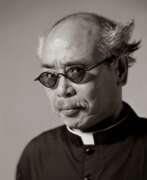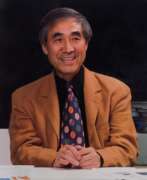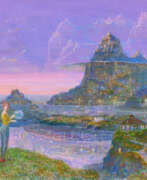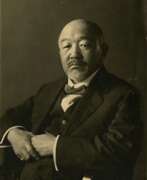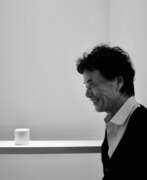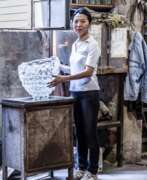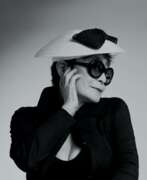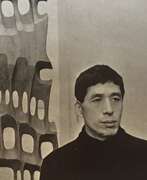Japan Contemporary art


Yō Akiyama (秋山 陽) is a Japanese ceramicist based in Kyoto. He was a late leading figure of Sōdeisha, a twentieth-century avant-garde artist group that sought to redefine understandings of aesthetics and purpose in modern and contemporary ceramics, focusing on sculptural attributes over strict functionality. Akiyama studied directly under Kazuo Yagi, one of the founders of Sōdeisha, for six years. Akiyama later became a professor at Kyoto Municipal University of Arts and Music, where he is currently a Professor Emeritus, having retired in 2018. As an artist, he works primarily with black pottery, a technique that fires clay in low temp, smoky conditions to create a dark effect. His predominantly largescale work is richly textural and abstract, emphasizing the earthy materiality of the work as well as its form.


Shusaku Arakawa was a Japanese conceptual artist and architect. He had a personal and artistic partnership with the writer and artist Madeline Gins that spanned more than four decades in which they collaborated on a diverse range of visual mediums, including: painting & printmaking, experimental filmmaking, performance art, and architectural & landscape design.


Kenjiro Adzuma (Japanese: 吾妻 兼治郎) is a Japanese abstraction sculptor known for his avant-garde and innovative approach to sculpture and installation art, one of Japan's most important post-World War II artists. He also lived and worked in Italy for many years. He studied sculpture at the Graduate School of Art at the University of Tokyo and at the Brera Academy of Fine Arts in Milan, where he attended Marino Marini's class.
Kenjiro Adzuma was a key figure in the Japanese art movement known as Mono-ha (School of Things) in the late 1960s and early 1970s. Mono-ha artists explored the relationship between natural and industrial materials, often juxtaposing them to create thought-provoking installations.




Tsugouharu Foujita was a French twentieth-century artist of Japanese descent. He is known for his unique style, combining elements of Japanese painting and printmaking with European realism.
Foujita created a wide range of works in a variety of genres, including nudes, images of cats, portraits of women and children, and self-portraits. He later converted to Catholicism and began creating paintings with religious themes. The artist was internationally recognized, and his work was exhibited in many countries around the world. His work was characterized by the perfection of pictorial technique, virtuosity of drawing and an atmosphere of sophistication. The master also showed talent in graphics, photography, ceramics, theater, cinema and fashion design. Prices for his paintings were comparable to those of Picasso's works.
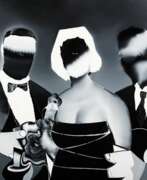

Tomoo Gokita is a leading contemporary Japanese artist on the international art scene. His deeply psychological monochrome abstract and figurative paintings and drawings in shades of grey represent cultural archetypes with distorted and hidden features against an ambiguous background.


Yozo Hamaguchi was a Japanese artist and copperplate engraver who revived the almost forgotten technique of mezzotint by the 20th century.
He studied at the Tokyo University of Art, traveled to Europe, worked in Paris, and participated in exhibitions. Hamaguchi innovatively inserted bright colors into his black-and-white mezzotints, producing surreal and abstract paintings.




She studied art in Japan, Spain and Germany.
Leiko Ikemura's work encompasses painting, sculpture, video and photography. She works in a variety of techniques, including oil painting, ceramic and bronze sculpture, printmaking and watercolor. She currently works in Cologne and Berlin and teaches painting at the Hochschule für Kunst in Berlin.


Toshimitsu Imai is a Japanese artist. He studied painting at the Tokyo State Academy of Art. He is known for his abstract paintings.
Toshimitsu Imai's work is dynamic and experimental. The artist has explored different techniques, including the use of unconventional materials and methods such as pouring, dripping and splashing paint onto canvases. His works were often characterised by bright colours, expressive brushwork and a sense of movement and energy.


Hiroki Iwata is one of the few Japanese metal artists who explore and experiment with enamel. He became the director of the Japan Enamel Artists Association in 2003. Hiroki Iwata is also a member of the Japan Handicraft Design Association. He has exhibited extensively in Japan and abroad in both solo and group exhibitions and has won many prizes. He is now a senior professor at Tokyo University of the Arts.




Funakoshi Katsura is a Japanese sculptor and one of Japan's leading figures in the visual arts. His woodwork, usually depicting human figures above the waist, is striking and distinctive. Funakoshi processes the material, leaving the structure of the wood and traces of the carvings visible. The artist carefully uses grit for modeling and leaves unpainted part of the figure's head.


Rei Kawakubo is a Japanese fashion designer based in Tokyo and Paris. She is the founder of Comme des Garçons and Dover Street Market. Although not formally trained as a fashion designer, Kawakubo did study fine arts and literature at Keio University. After graduation she worked in the advertising department at the textile company Asahi Kasei and she went on to work as a freelance stylist in 1967. Two years later, she began to design and make her own clothes under the label Comme des Garçons. In 1969, she established her own company, Comme des Garçons Co. Ltd in Tokyo and opened up her first boutique there in 1975. Starting out with women's clothes, Kawakubo added a men's line in 1978. Three years later, she started presenting her fashion lines in Paris. Comme des Garçons specialises in anti-fashion, austere, sometimes deconstructed garments. Kawakubo likes to have input in all the various aspects of her business, rather than just focusing on clothes and accessories. She is greatly involved in graphic design, advertising, and shop interiors believing that all these things are a part of one vision and are inextricably linked.


Hideaki Kawashima is a Japanese artist who lives and works in Tokyo.
After graduating from the University of Tokyo, he underwent two years of Buddhist temple training before beginning his career as an artist in 2001.
Hideaki Kawashima uses portrait painting and self-portrait masks to show the ambiguity of human life. His characters with expressive eyes express a spectrum of emotions: fear, desire, anxiety, longing. Yet these emotions are ambiguous. Kawashima brings touches of folklore, mythology and surrealism to androgynous faces.


Yayoi Kusama is a Japanese contemporary artist who works primarily in sculpture and installation, but is also active in painting, performance, video art, fashion, poetry, fiction, and other arts. Her work is based in conceptual art and shows some attributes of feminism, minimalism, surrealism, Art Brut, pop art, and abstract expressionism, and is infused with autobiographical, psychological, and sexual content. She has been acknowledged as one of the most important living artists to come out of Japan.


Hiroyuki Masuyama is a prolific artist and photographer renowned for his innovative approach to visual art. Masuyama's journey into the world of art began with his education in Tokyo, where he graduated from the Tokyo National University of Fine Arts and Music, and continued with further studies in mural painting at the Graduate School of the same university. He later expanded his academic horizons to include studies in Düsseldorf, Germany, where he now lives and works.
Hiroyuki Masuyama is celebrated for his intricate lightbox artworks that reimagine the landscapes and seascapes by renowned artists like J.M.W. Turner, offering a contemporary perspective on these classic scenes. His work involves a meticulous process of digital photography, where he captures thousands of images to recreate historical artworks or landscapes in a new light, essentially blending time, space, and medium. His projects, such as the detailed reinterpretation of Turner's journeys and the "Rome 1585-2012" solo show, showcase his commitment to bridging historical art with modern photographic techniques.
Moreover, Hiroyuki Masuyama has engaged in ambitious projects that document landscapes in a way that challenges traditional perceptions. His exhibitions, like "Nature" at Artoll Kunstlabor and "Mountain" at Merck Finck & Co., demonstrate his fascination with nature and historical sites, encapsulating them within the modern framework of LED lightboxes.
Hiroyuki Masuyama's work has garnered international attention, leading to exhibitions across Europe and Asia. His innovative use of technology to merge photography with painting invites viewers to explore the intersections of history, art, and contemporary media.
For collectors and experts in art and antiques, Hiroyuki Masuyama offers a unique blend of historical reverence and contemporary innovation. His artworks not only pay homage to the past but also challenge viewers to consider the ways in which modern technology can alter our perception of historical and natural landscapes.
Stay updated on Hiroyuki Masuyama's latest projects, exhibitions, and available works by signing up for updates from galleries and museums that feature his art. This subscription will ensure you are informed about new product sales and auction events related to Masuyama's work, offering insights into the fusion of traditional themes with contemporary art forms.


Takesada Matsutani (Japanese: 松谷 武判) is a Japanese contemporary mixed-media artist. He was a member of the Gutai group from 1963 to the dissolution of the group in 1972. His well-known work involves a technique of blowing a gust of air into a puddle of vinyl wood glue, creating bulges, bubbles, and drips, then covered by patient strokes of graphite pencil. Matsutani's works are represented in a large number of prestigious art museums and collections around the world.


Jonathan Meese is a German painter, sculptor, performance artist and installation artist based in Berlin and Hamburg. Meese's (often multi-media) works include paintings, collages, drawings and writing. He also designs theater sets and wrote and starred in a play, De Frau: Dr. Poundaddylein — Dr. Ezodysseusszeusuzur in 2007 at the Volksbühne Theater. He is mainly concerned with personalities of world history, primordial myths and heroes. Jonathan Meese lives and works in Ahrensburg and Berlin.


Daidō Moriyama (Japanese: 森山 大道) is a Japanese photographer best known for his black-and-white street photography and association with the avant-garde photography magazine Provoke. Moriyama’s rough, unfettered photographic style makes use of sharply tilted angles, grainy textures, harsh contrasts, and blurred movements to capture the rawness of human experience as seen through the photographer’s wandering gaze. Many of his well-known works from the 1960s and 1970s are read through the lenses of post-war reconstruction and post-Occupation cultural upheaval.


Takashi Murakami is a Japanese contemporary artist. He works in fine arts media (such as painting and sculpture) as well as commercial (such as fashion, merchandise, and animation) and is known for blurring the line between high and low arts as well as co aesthetic characteristics of the Japanese artistic tradition and the nature of postwar Japanese culture and society, and is also used for Murakami's artistic style and other Japanese artists he has influenced.
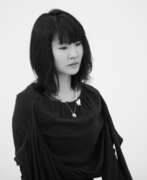

Tomoko Nagai is a Japanese artist who lives and works in Japan.
She graduated from the University of Fine Arts and Music of Aichi Prefecture with a degree in oil painting.
Tomoko Nagai is known for her whimsical, puppet fantasy creatures painted in mixed media. She depicts animals, children, colorful trees and mushrooms as in a theatrical setting. Nagai's most famous work is located in a kindergarten in one of Japan's earthquake-stricken areas, in Shichigahama, Miyagi, where she painted the walls of a swimming pool.


Osamu Nakajima is a Japanese-Austrian sculptor of Asian modern and contemporary art. He is one of the first artists who were able to realize pure abstraction for sculptures in public space. His monochrome stone sculptures are based on basic geometric forms and rational principles of order, which, however, find new and unusual solutions.


Yoshitomo Nara is a Japanese artist. He lives and works in Nasushiobara, Tochigi Prefecture, though his artwork has been exhibited worldwide. Nara has had nearly 40 solo exhibitions since 1984. His art work has been housed at the MoMA and the Los Angeles County Museum of Art (LACMA).


Katsuhito Nishikawa is a Japanese-German artist, sculptor, designer and architect.
After studying in Japan, he received degrees from the Academy of Fine Arts in Munich and the State Academy of Fine Arts in Düsseldorf. He currently lives and works as a visual artist and furniture designer at Insel Hombroich in Neuss, Germany. Katsuhito Nishikawa is also a visiting professor at the art universities of Hamburg (Germany) and Reims (France).


Yoshishige Saitō was a Japanese visual artist and art educator.
Saitō was a seminal figure in Japanese art of the 20th century and a crucial link between the prewar avant-garde and postwar abstract art in Japan. From early on, he was exposed to Post-Impressionism and the avant-garde movements, including Russian constructivism and European Dada, as well as Western literature and Marxism. In the 1930s, he became active in the avant-garde art circles, while pursuing abstraction in paintings and wood reliefs, most notably the relief series of Kara kara and Toro Wood. All of his prewar works and related materials were lost to an air-raid fire in 1945, some of them were reconstructed in the 1970s.


Makoto Saitō is a Japanese graphic designer, self-described "poster designer", and artist. Saitō was born in Fukuoka, Japan. His early work as a printmaker was successful, shown internationally, and is part of the collection of the Museum of Modern Art in New York. Saitō worked from 1974 to 1980 at Nippon Design Center before starting his own firm, Makoto Saitō Design. His posters are typified by text-free imagery in dense inks printed on thick, high quality papers. His wide-ranging creative activities explore perpetual theme of “seeing.”


Fumie Sasabuchi is a Japanese artist living and working in Berlin.
Fumie studied painting at Tama Art University in Tokyo and then at the Academy of Fine Arts in Munich. The artist flirts with the theme of death, depicting human entrails and bones with anatomical precision on the surface of the skin of the depicted person, in the form of tattoos. Sasabuchi's work is based on photographs from fashion magazines or horror movies, which she reworks in her own style.
Perhaps some of the motifs in Fumie Sasabuchi's work have roots in Japanese Yakuza culture. Juxtaposed with the European taboo theme of depicting death, the result of her work may shock or at least amaze.
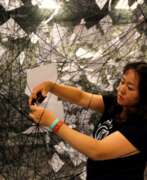

Chiharu Shiota is a Japanese performance and installation artist. Educated in Japan, Australia, and Germany, Shiota interweaves materiality and the psychic perception of the space to explore ideas around the body and flesh, personal narratives that engage with memory, territory, and alienation. Her signature installations, which consist of dazzling, intricate networks of threads stretching across gallery rooms, made the artist rise to fame in the 2000s. Shiota has exhibited worldwide and represented Japan in the 56th Venice Biennale in 2015.


Yanagi Sōri (柳 宗理) was a Japanese industrial designer. He played a role in Japanese modern design developed after World War II to the high-growth period in the Japanese economy. He is both a representative of the wholly Japanese modern designer and a full-blown modernist who merged simplicity and practicality with elements of traditional Japanese crafts.
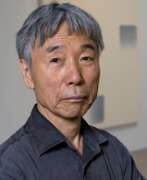

Lee Ufan is a Korean-Japanese artist. He is a leading figure of the Mono-ha movement, which emerged in Japan in the late 1960s and emphasized the relationships between natural and industrial materials, space, and perception.
Lee Ufan moved to Japan in 1956 and studied philosophy at Nihon University in Tokyo. In the late 1960s, he began to create minimalist sculptures and installations that explored the interactions between natural and industrial materials such as stone, metal, and glass.
In addition to his work as a visual artist, Lee Ufan is also a noted writer and philosopher. He has written extensively on aesthetics, contemporary art, and Zen Buddhism.
Lee Ufan's work has been exhibited in major museums and galleries around the world, including the Guggenheim Museum in New York, the Centre Georges Pompidou in Paris, and the National Museum of Modern and Contemporary Art in Seoul. He has also been the subject of several major retrospectives, including exhibitions at the Solomon R. Guggenheim Museum in New York in 2011 and the Centre Pompidou in Paris in 2014.






